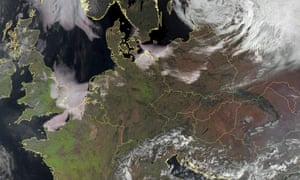Using big data could alert us to risks in the food supply chain
Chocolate, coffee and other popular commodities face supply chain scares, but big data can help secure and improve farming yields around the world

As shoppers, we’ve become used to the reliable presence of brands in supermarkets. The idea of food scarcity and disruption to supplies doesn’t come into plans for our weekly food shop.
But the reality for many global food manufacturers is uncertainty. Chocolate production is one example. Some 40% of the world’s cocoa comes from the Ivory Coast, grown on farms with only a few hectares of cocoa trees. In China alone, US firm The Hershey Company estimates that sales of chocolate will grow 60%between 2014 and 2019 to a value of $4.3bn. This is partly thanks to a new-found love of chocolate among China’s growing middle classes.
But it’s not just chocolate. The problem is widespread, particularly with ingredients that only grow in specific climates, such as vanilla, tea, coffee and palm oil. Last year, the global coffee market saw shortages partly due to a drought in Brazil. This led to steep price rises and prompted Starbucks to acquire a new 600-acre Arabica farm in Costa Rica to study sustainability issues first hand.
A shortage of palm oil has been a recurring political issue in Thailand, where it’s a staple in household cooking. The government resorted to importing palm oil from neighbours in 2011 to ease what was becoming a national crisis.
The supply of vanilla has also been unstable. Supplied by a small number of farms where it is a very minor crop, there have previously been occasions of oversupply and low prices, so farmers naturally shifted their land to grow more lucrative crops. Bad weather in India and Mexico in 2012 led to a scarcity of vanilla pods and steep price rises in 2013. The shortfall in supplies was made up for by relying on farmers in Madagascar.
Big data and small farms
Food production in these supply chains is often based on large numbers of small farmers, working on different types of land using different techniques.
In other industries, such as automotive, there are global networks of information-sharing among players in supply chains which can result in significant cost reductions, reliability and sustainability benefits. Aston Martin, Jaguar Land Rover and Toyota Motor Europe, for example, share a system for identifying and managing potential risks around health and safety, financial stability and ethics in their supply chains. The global car manufacturers also use an online portal with updated information, as well as data from a standard financial health-check on suppliers in the chain.
However, due to the food industry’s fragmented supply system, integrating suppliers and producers has proven far more technologically challenging. There is hope though. New technological advances in crop sensors and an increase in the number of satellites that can monitor fields and farms means that the potential to improve efficiencies could now be realised. A European Commissionprogramme for example, is using satellite earth-observation data to gather information on crop production and check the validity of farmers’ applications for EU subsidies.
Satellite-based monitoring systems have been widely used since the 70s to assess the use and management of land, but have tended to provide just a general picture of crop production. Improvements in the satellite sensor quality as well as changes in the availability of satellite images means that we now have access to near-daily earth observation capability at much higher resolution than before.
Investment needed
A combination of different types of remote sensing data alongside detailed information from the ground can create a more accurate picture of the extent of production and the likely levels of yield now and for the future. It is something we are trialling at Cranfield University on everything from lettuces in the UK to illicit opium production in Afghanistan.
The availability of big data analysis means it’s possible to take into account many more of the variable factors involved in agriculture and set out a clearer picture of future trends and risks. An ideal scenario would also involve more micro-perspectives to understand soil degradation and water scarcity issues to secure and improve marketable yields further.
Big picture monitoring information makes it possible to better manage farmers and offer the right kinds of incentives and disincentives to balance their immediate needs against those of long-term sustainability.
In practice, the attitudes in industry will put limitations on this kind of mapping. Governments as well as businesses must invest in this technology but for this to happen there needs to be the will for change and openness about the realities of supply chain instability.
No comments:
Post a Comment